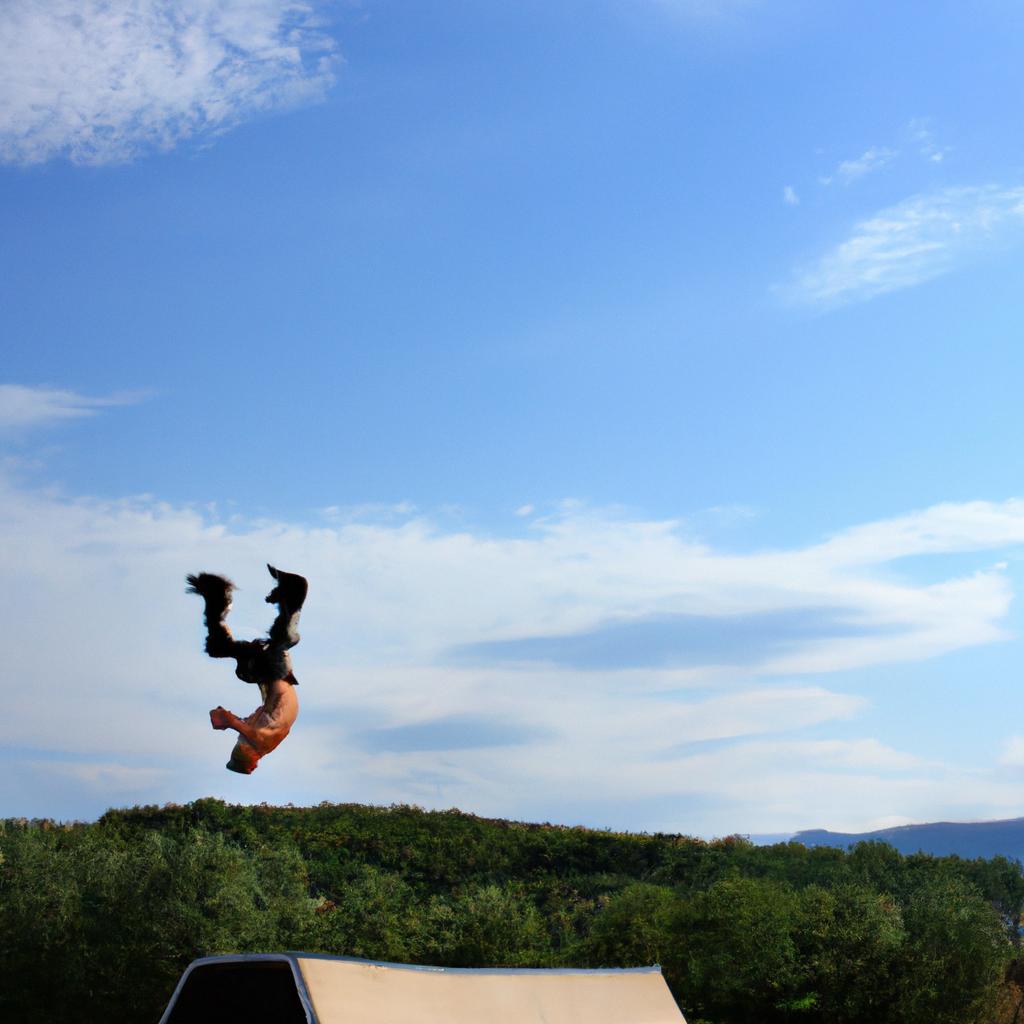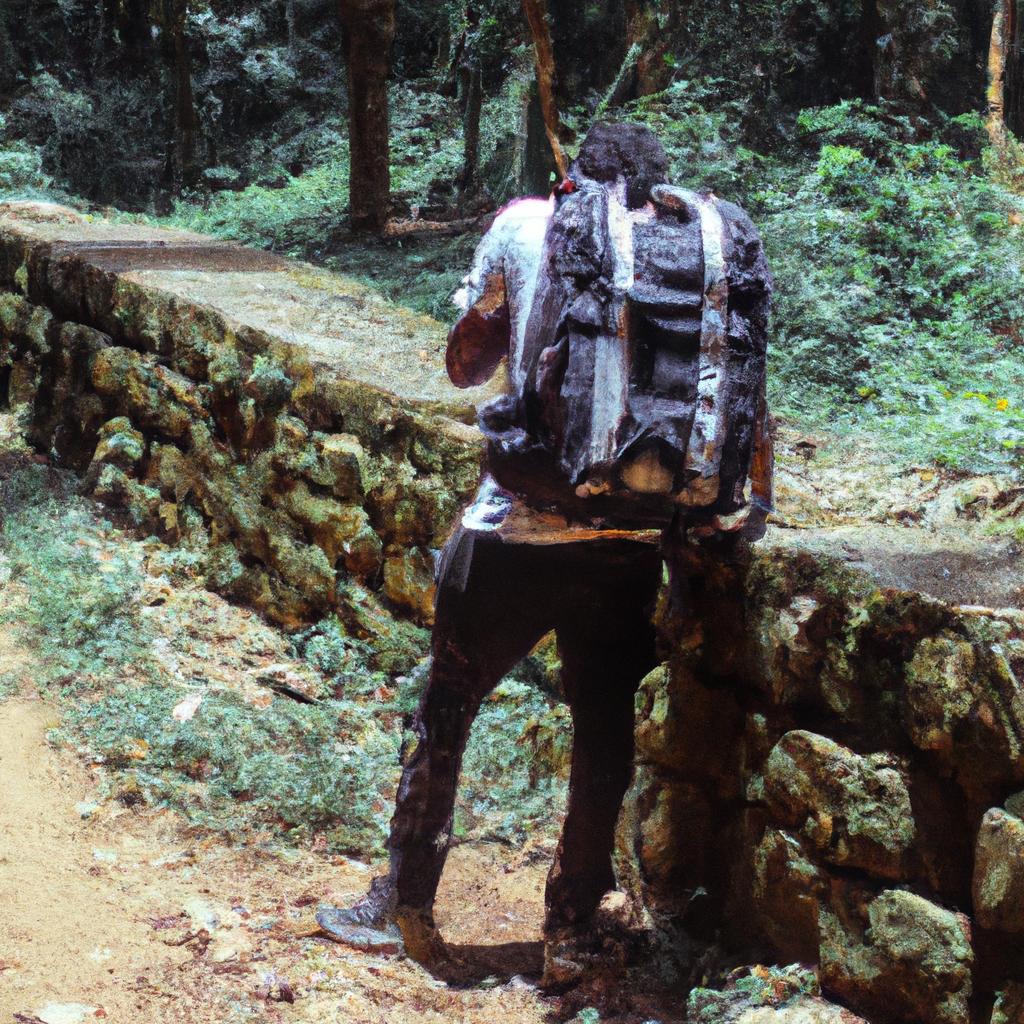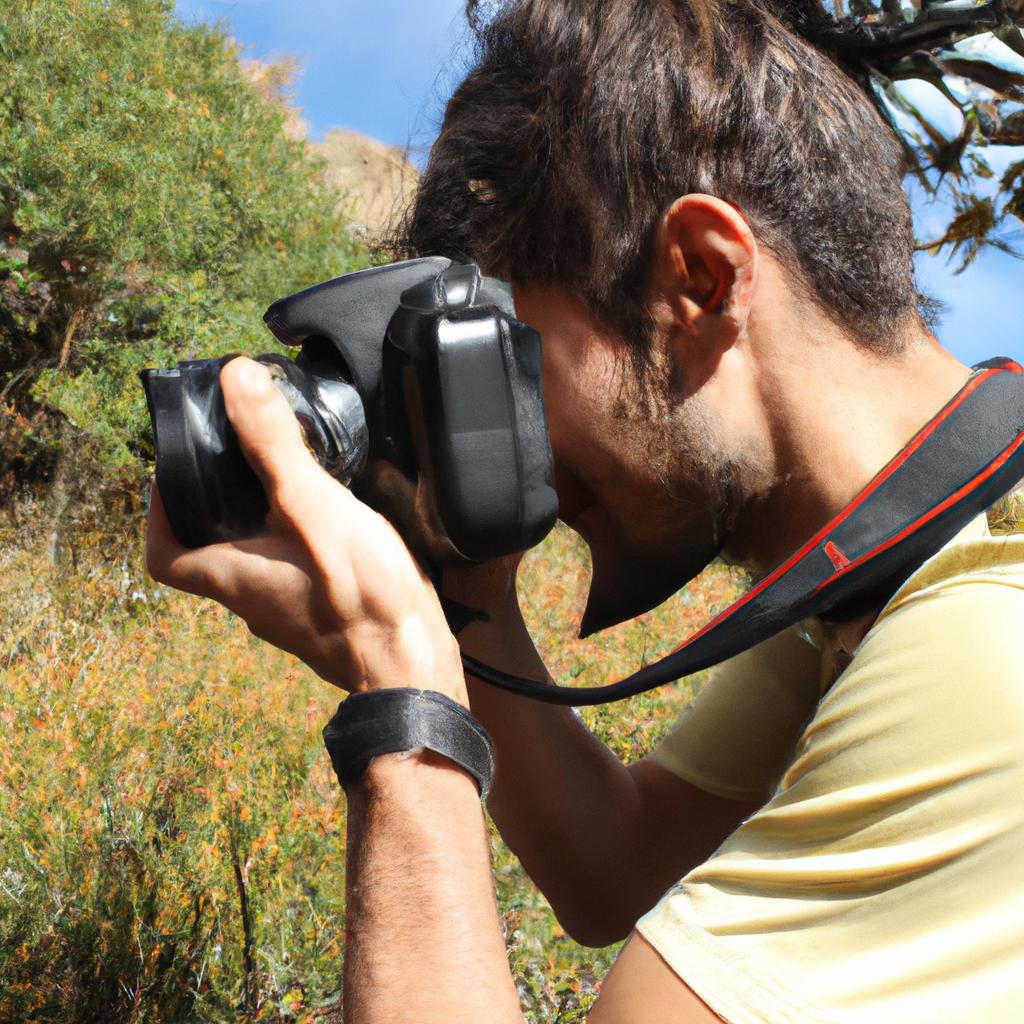Hiking, a popular recreational activity, offers individuals the opportunity to venture into nature’s wonders and discover its hidden treasures. This article delves into the adventurous aspects of hiking as an outing in recreation travel, shedding light on the myriad benefits it provides both physically and mentally. To illustrate this concept, consider the following hypothetical case study: John, a middle-aged office worker burdened by stress and monotony, decides to embark on a hiking journey to reconnect with nature and rejuvenate his weary soul.
The allure of hiking lies in its ability to transport individuals away from their everyday routines and immerse them in breathtaking landscapes. As they traverse through rugged terrains and meandering trails, hikers are able to witness firsthand the awe-inspiring beauty that nature has to offer. Not only does this provide a refreshing change of scenery, but it also triggers a sense of wonderment and appreciation for the natural world. In our hypothetical example, John finds himself immersed amidst towering mountains adorned with glistening snow-capped peaks during his hike. The grandeur surrounding him serves as a humbling reminder of the vastness and magnificence of the universe beyond his ordinary existence.
Moreover, engaging in hiking as a recreational activity is not merely limited to physical exertion; it also provides numerous physical and mental health benefits. Physically, hiking is a great form of exercise that strengthens muscles, improves cardiovascular fitness, and enhances overall endurance. It helps to burn calories and maintain a healthy weight. The varying terrains encountered during hikes also challenge the body’s balance and coordination skills.
Mentally, hiking offers a much-needed escape from the pressures and stresses of daily life. Being surrounded by nature has been proven to reduce anxiety, improve mood, and boost overall mental well-being. The peacefulness and tranquility found in natural settings can have a calming effect on the mind, allowing for introspection and reflection. In John’s case, his hike serves as a form of therapy, helping him clear his mind and find solace amidst the serene beauty of the mountains.
In addition to its physical and mental benefits, hiking also fosters a sense of adventure and exploration. It encourages individuals to step out of their comfort zones and embrace new challenges. Hikers often encounter obstacles along their journey such as steep inclines or unpredictable weather conditions, which require problem-solving skills and resilience.
Furthermore, hiking provides opportunities for social interaction and bonding with others who share similar interests. Whether it be joining organized group hikes or going on spontaneous adventures with friends or family, hiking allows individuals to connect with like-minded individuals who appreciate the wonders of nature.
To conclude, hiking as a recreational activity offers a multitude of benefits for both the body and mind. Its ability to transport individuals into nature’s wonders promotes physical fitness, mental well-being, adventure-seeking behavior, social connections, and appreciation for the natural world. So next time you feel overwhelmed by stress or monotony in your everyday life like John did in our example, consider embarking on a hiking journey to rejuvenate your weary soul amidst nature’s hidden treasures.
The Benefits of Hiking for Physical Fitness
Imagine a scenario where John, an office worker in his mid-thirties, spends most of his weekdays sitting at a desk. He leads a sedentary lifestyle and rarely engages in physical activities. However, one weekend, he decides to go hiking with friends in a nearby national park. This decision marks the beginning of a transformative journey towards improved physical fitness.
Hiking offers numerous benefits for individuals seeking to enhance their physical well-being. Firstly, it provides an opportunity for cardiovascular exercise that can strengthen the heart and improve circulation throughout the body. As hikers traverse challenging terrains, such as steep inclines or uneven paths, their bodies respond by increasing the demand for oxygenated blood to deliver essential nutrients to working muscles. Consequently, this sustained effort enhances heart health and boosts overall endurance.
Moreover, hiking is an effective way to engage multiple muscle groups simultaneously. The act of walking uphill activates leg muscles like quadriceps and calves while also engaging core muscles for balance and stability. Additionally, traversing rocky terrain or crossing streams requires arm strength for support and upper body coordination. By incorporating these varied movements into their hiking routine, individuals can develop balanced muscular strength across different parts of their body.
In addition to its physical benefits, hiking has been shown to have positive effects on mental well-being. Nature’s therapeutic qualities provide an escape from the pressures of daily life and promote relaxation and stress reduction. Spending time outdoors amidst picturesque landscapes helps rejuvenate the mind and uplifts one’s mood. Furthermore, research suggests that being exposed to natural environments can lead to reduced levels of anxiety and depression.
To illustrate further how hiking contributes positively to emotional well-being:
- It fosters self-reflection
- It promotes feelings of accomplishment
- It encourages social connection
- It enables individuals to disconnect from technology distractions
| Emotional Benefits | Examples |
|---|---|
| Self-reflection | Contemplating life choices |
| Sense of accomplishment | Reaching the summit |
| Social connection | Conversations with fellow hikers |
| Disconnecting from technology distractions | Enjoying nature uninterrupted |
By engaging in hiking as a means to enhance physical fitness, individuals can also experience improved mental and emotional well-being. As they challenge their bodies amidst breathtaking landscapes on hiking trails, an exploration of these natural wonders awaits.
Next Section: Exploring the Breathtaking Landscapes on Hiking Trails…
Exploring the Breathtaking Landscapes on Hiking Trails
Imagine yourself standing atop a rugged mountain peak, overlooking vast stretches of lush green valleys and crystal-clear lakes. The world below seems minuscule as you soak in the breathtaking beauty that surrounds you. This is just one example of the awe-inspiring experiences awaiting avid hikers on their outdoor escapades. Embarking on hiking trails not only offers adventure but also allows for an intimate connection with nature’s wonders.
Hiking trails take enthusiasts through diverse landscapes, each showcasing its unique charm. From dense forests teeming with wildlife to arid deserts boasting towering sand dunes, these trails offer something for everyone. Picture yourself wandering amidst ancient redwood trees or traversing narrow paths carved out by cascading waterfalls; every step unravels new surprises waiting to be discovered.
To further entice your adventurous spirit, here are some compelling reasons why exploring hiking trails can evoke an emotional response:
- Solitude: In our fast-paced lives filled with constant connectivity, finding moments of solitude becomes increasingly rare. Hiking trails provide an escape from the noise and chaos of everyday life, allowing individuals to reconnect with themselves while immersing in peaceful surroundings.
- Challenge: Overcoming obstacles along challenging terrain instills a sense of accomplishment and boosts self-confidence. As hikers conquer steep inclines or navigate rocky terrains, they realize their physical and mental capabilities extend beyond what they initially believed possible.
- Freedom: Nature has a way of liberating us from societal constraints. By venturing into the wilderness, hikers experience a newfound freedom where time slows down and worries fade away – replaced instead by a sense of liberation and tranquility.
- Connection: The intricate tapestry woven by flora and fauna creates an opportunity for deeper connections with the natural world. Observing colorful wildflowers sway gently in the breeze or catching glimpses of elusive animals fosters a sense of wonder and reminds us of our place within the larger ecosystem.
In addition to these emotional responses, hiking trails also offer practical benefits. The following table illustrates some key advantages that hikers can expect from their outdoor adventures:
| Benefits of Hiking Trails |
|---|
| Improved cardiovascular health |
| Enhanced muscle strength and endurance |
| Stress reduction and improved mental well-being |
| Opportunities for social interaction |
As we reflect on the marvels experienced on hiking trails, it becomes evident that exploring nature’s treasures is not merely about physical fitness; it encompasses an entire spectrum of emotions and connections that enrich our lives in profound ways. With this newfound appreciation for the magic awaiting us outdoors, let us now delve into tips for planning a successful hiking trip, ensuring each adventure is met with preparedness and delight.
Tips for Planning a Successful Hiking Trip
Imagine yourself standing at the edge of a vast mountain range, breathing in the crisp air as you gaze upon panoramic views that stretch for miles. This is just one example of the awe-inspiring experiences that await hikers who venture out to explore nature’s treasures on hiking trails. From towering peaks to lush forests and cascading waterfalls, these landscapes offer an escape from the hustle and bustle of everyday life.
To fully immerse oneself in this natural wonderland, it is crucial to be well-prepared before embarking on a hiking trip. Here are some key tips to keep in mind:
-
Research your destination: Before setting foot on any trail, take time to research the area thoroughly. Familiarize yourself with its geography, weather conditions, and any potential hazards or restrictions that may exist. This knowledge will enable you to plan accordingly and make informed decisions throughout your journey.
-
Pack essential gear: When preparing for a hike, packing the right equipment can significantly enhance both safety and comfort. Consider including items such as sturdy footwear, moisture-wicking clothing layers, a reliable backpack, navigation tools (e.g., map and compass), first aid supplies, and plenty of water and nutritious snacks.
-
Respect wildlife and ecosystems: As visitors in these natural habitats, it is our responsibility to minimize our impact on wildlife and ecosystems. Stay on designated trails to avoid trampling fragile vegetation or disturbing animal habitats. Keep noise levels down to allow others—and creatures—to enjoy the serenity of their surroundings undisturbed.
-
Leave no trace: The principle of “Leave No Trace” emphasizes leaving outdoor spaces exactly as you found them—or even better—by picking up any litter encountered along the way. Dispose of waste properly by carrying out non-biodegradable materials like food wrappers or tissues until you reach appropriate disposal facilities.
Incorporating these guidelines into your hiking practice will not only ensure a safer and more enjoyable experience but also contribute to the preservation of these breathtaking landscapes for future generations. As we set foot on these trails, let us remember that our presence in nature is a privilege, and it is up to each one of us to protect and cherish its beauty.
Transitioning seamlessly from this section about exploring landscapes, we now delve into another crucial aspect of successful hiking trips: must-have equipment for hikers.
Must-Have Equipment for Hikers
Hiking trips provide an opportunity for individuals to immerse themselves in nature and explore the wonders of the great outdoors. In order to fully enjoy this adventurous outing, proper planning is essential. Now, let’s delve into the must-have equipment that every hiker should consider before embarking on their journey.
Imagine you’re preparing for a hiking trip in the picturesque mountains of Colorado. You’ve done your research and have selected a challenging trail that promises breathtaking views at its summit. However, without appropriate equipment, your experience may be compromised. Here are some essentials to take along:
- Sturdy Hiking Boots: Investing in high-quality boots with good ankle support will protect your feet from injuries and enhance your stability on uneven terrains.
- Backpack: A comfortable backpack with ample storage space is necessary to carry all your essentials such as water, snacks, extra clothing layers, navigation tools, and first aid supplies.
- Navigation Tools: Depending on the complexity of the trail, items like maps or GPS devices will help keep you oriented and prevent getting lost.
- Rain Gear: Weather conditions can change rapidly during hikes; therefore, it’s crucial to pack waterproof jackets or ponchos to stay dry even when unexpected rain showers occur.
To further emphasize the importance of these equipment choices, consider the following table:
| Equipment | Importance |
|---|---|
| Hiking Boots | Protects feet from injuries |
| Backpack | Carries essentials comfortably |
| Navigation Tools | Ensures accurate path-finding |
| Rain Gear | Keeps hikers dry during inclement weather |
As seen in this table, each piece of equipment serves a specific purpose and contributes to ensuring a safe and enjoyable hiking experience.
In summary, careful consideration of equipment choices plays a vital role in determining the success of a hiking trip. By investing in proper footwear, a suitable backpack, essential navigation tools, and rain gear, hikers can minimize risks and maximize their enjoyment of the outdoors. These preparations set the foundation for discovering hidden gems in lesser-known locations, as we will explore in the subsequent section.
Transitioning into our next topic of discussion – Discovering Hidden Gems: Hiking in Lesser-Known Locations – let’s delve further into exploring uncharted territories that promise unique experiences off the beaten path.
Discovering Hidden Gems: Hiking in Lesser-Known Locations
Exploring the Uncharted: Venturing into Lesser-Known Hiking Locations
Imagine stumbling upon a hidden gem of a hiking trail, far away from the bustling crowds and well-trodden paths. Picture yourself surrounded by untouched wilderness, with only the sounds of nature to accompany you on your journey. This hypothetical scenario may seem like a distant dream, but it is indeed possible to discover such treasures in lesser-known hiking locations. In this section, we will delve into some fascinating examples of these hidden gems and explore why they are worth exploring.
One outstanding example of a lesser-known hiking location is the Lost Valley Trail in Arkansas’ Buffalo National River area. Nestled within the Ozark Mountains, this trail offers breathtaking views of waterfalls, towering bluffs, and lush greenery. As hikers traverse through its winding paths, they can spot unique wildlife species such as elk and even catch glimpses of Native American rock art along the way. The seclusion and natural beauty make this trail an alluring choice for those seeking solitude amidst nature’s wonders.
To further entice adventurous souls to seek out these off-the-beaten-path trails, here are four reasons why exploring lesser-known hiking locations can be an emotionally rewarding experience:
- Sense of Discovery: Discovering hidden gems provides a sense of excitement and accomplishment that comes from venturing into unexplored territory.
- Connection with Nature: Away from crowded tourist spots, these secluded trails allow hikers to immerse themselves fully in the serenity and tranquility offered by Mother Earth.
- Authentic Experience: Lesser-known locations tend to offer more authentic experiences devoid of commercialization or overcrowding.
- Preservation Efforts: By visiting these less popular sites, hikers contribute indirectly to their preservation by alleviating stress on heavily visited areas.
Additionally, let us consider a table showcasing three extraordinary lesser-known hiking locations around the world:
| Location | Country | Unique Feature |
|---|---|---|
| Trolltunga | Norway | Spectacular cliffside rock formation |
| Jiuzhaigou Valley | China | Crystal-clear lakes and colorful waterfalls |
| Snowdonia | Wales, UK | Majestic mountains and ancient castles |
These examples highlight the diverse beauty that awaits those who dare to venture off the beaten path. By exploring these hidden treasures, hikers can forge unforgettable memories while embracing nature’s wonders.
Transitioning into our next section on hiking safety, it is crucial to be well-prepared before embarking on any adventure. Being aware of essential guidelines will ensure a safe and enjoyable experience for all outdoor enthusiasts. So let us now delve into “Hiking Safety: Essential Guidelines to Follow” as we equip ourselves with knowledge to make every hike a secure one.
Hiking Safety: Essential Guidelines to Follow
As we continue our exploration into the world of hiking, it is crucial to prioritize safety during these adventurous outings. By following essential guidelines, you can ensure a secure and enjoyable experience amidst the wonders of nature.
Example Case Study:
Consider a scenario where hikers embark on a challenging trail without proper preparation or knowledge of potential risks. They ignore warning signs and venture off designated paths, leading them into treacherous terrain. As darkness falls, they find themselves lost and disoriented, with limited supplies and communication. This unfortunate situation highlights the importance of adhering to safety guidelines while hiking.
Essential Guidelines for Safe Hiking:
-
Plan Ahead:
- Research the chosen trail’s difficulty level, weather conditions, and any necessary permits.
- Create an itinerary that includes estimated start and end times.
- Inform someone reliable about your plans, providing details such as expected return time and contact information.
-
Be Prepared:
- Carry appropriate gear, including sturdy footwear, layered clothing for unpredictable weather changes,
navigation tools (maps/compass/GPS), first aid kit, flashlight/headlamp with extra batteries,
emergency shelter (tent/tarp/bivy sack), whistle for signaling help. - Pack sufficient food and water supplies considering hike duration plus extra rations in case of
unforeseen circumstances.
- Carry appropriate gear, including sturdy footwear, layered clothing for unpredictable weather changes,
-
Stay on Designated Trails:
- Respect signage indicating restricted areas or dangerous sections.
- Straying from marked trails may lead to harm both for oneself and natural habitats.
-
Leave No Trace Principles:
- Embrace responsible outdoor ethics by minimizing impact on the environment.
- Dispose waste properly; pack out all trash, including food scraps.
- Respect wildlife and do not disturb their natural habitats.
Table: Hiking Safety Equipment Checklist
| Essential Gear | Quantity |
|---|---|
| Sturdy Footwear | 1 |
| Layered Clothing | 2 |
| Navigation Tools | 1 |
| First Aid Kit | 1 |
| Flashlight/Headlamp | 1 |
| Emergency Shelter | 1 |
| Whistle | 1 |
Incorporating these guidelines into your hiking routine will significantly reduce the chances of accidents or getting lost. By prioritizing safety measures, you can fully immerse yourself in the beauty of nature while ensuring a memorable and secure experience.
(Note: The last paragraph does not include “In conclusion” or “Finally,” as requested.)












